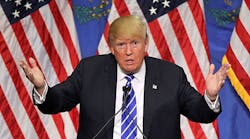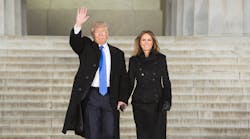Author: Patricia Laya
U.S. employers added jobs at an above-average pace for a second month on outsized gains in construction and manufacturing while wage growth picked up, as the labor market continued its steady improvement in the new year.
The 235,000 increase followed a 238,000 rise in January that was more than previously estimated, the best back-to-back rise since July, a Labor Department report showed Friday in Washington. The unemployment rate fell to 4.7%, and wages grew 2.8% from February 2016.
While unseasonably warm weather may have boosted the payrolls count, the data represent President Donald Trump’s first full month in office and coincide with a surge in economic optimism following his election victory. The figures also validate recent comments by Federal Reserve officials that flagged a likely interest-rate increase this month.
“We’re getting closer and closer to full employment,” said Ryan Sweet, an economist at Moody’s Analytics Inc. in West Chester, Pennsylvania. “Wages had been the one sore spot in the labor market data, and I think that’s coming through here. With inflation accelerating I think we’re going to start to see even stronger wage growth down the road.”
The prospect of a Fed rate increase at its meeting next week is “pretty much a slam dunk,” he said.
Trump, via a post on his Twitter account in a retweet of a Drudge Report headline, seized on the report: “GREAT AGAIN: +235,000”.
Private employment, which excludes government agencies, rose by 227,000 after a 221,000 increase the prior month. It was the biggest gain since July. Construction jobs, which can fluctuate depending on the weather, rose by 58,000, the strongest in almost a decade, and followed a 40,000 increase in January. Manufacturing payrolls gained 28,000, matching the most since August 2013. Meanwhile, retail positions fell by 26,000, the most in four years.
Last month was the second-warmest February on record in the contiguous 48 U.S. states, with an average temperature of 41 degrees Fahrenheit (5 degrees Celsius), about 7 degrees higher than the 20th century average, according to the National Oceanic and Atmospheric Administration.
Just 157,000 people were unable to work in February because of inclement weather, compared with an average of 311,000 for the month, according to the Labor Department. In January, 395,000 employees couldn’t work because of the weather.
Even so, the figures indicate that the drivers of consumer spending probably remain intact after purchases slowed in January, suggesting that any easing of first-quarter economic growth will be temporary. Fed Chair Janet Yellen said last week that the labor market is “in the vicinity of our maximum employment objective.”
Employment Outlook
At the same time, payroll gains are forecast to slow, owing to factors including employers’ difficulty filling positions and tepid growth in the working-age population. For the full year, economists project an average monthly increase of 171,000 jobs, according to a February survey.
Trump has set a goal of adding 25 million jobs over 10 years, which would require additions of 208,000 a month, or 2.5 million positions a year.
“We’re probably not going to get 200,000-plus jobs in the next couple of months,” said Sweet of Moody’s. “Favorable weather probably pulled up some hiring, particularly in construction.”
The median forecast in a Bloomberg survey of economists called for a 200,000 advance in February. Estimates ranged from gains of 150,000 to 275,000. January was initially reported as a 227,000 increase.
Revisions to the previous two months added a total of 9,000 jobs to payrolls.
The unemployment rate, which is derived from a separate Labor Department survey of households, fell as employment increased by 447,000. The jobless rate matched the median projection of 4.7%.
Participation Rate
The participation rate, which shows the share of working-age people in the labor force, increased to 63%, the highest since last March, from 62.9%. It has been hovering close to the lowest level in more than three decades.
The number of people out of the labor force, a figure repeatedly highlighted by Trump as a sign of economic malaise, fell by 176,000 to 94.2 million.
Government employment rose by 8,000. Federal payrolls increased by 2,000 in the first full month of the Trump administration’s hiring freeze for agency employees not involved in national security. State and local agencies added 6,000 workers.
Average hourly earnings rose by 0.2% from the previous month. January’s year-over-year increase was revised up to a 2.6% gain. The average work week for all workers was unchanged at 34.4 hours.














